Salyut 5
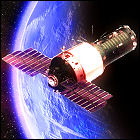 The Soviet Union launches the two-ton Salyut 5 space station into Earth orbit. Salyut 5 is the final Soviet space station to utilize the Almaz military station architecture originally specified in the 1960s (at which time Almaz was developed to counter the perceived threat from the never-launched American Manned Orbiting Laboratory). The station carries Earth surveillance equipment and a return capsule for later retrieval of experiments and film. Salyut 5 remains in orbit for a little over a year, visited by only two crews.
The Soviet Union launches the two-ton Salyut 5 space station into Earth orbit. Salyut 5 is the final Soviet space station to utilize the Almaz military station architecture originally specified in the 1960s (at which time Almaz was developed to counter the perceived threat from the never-launched American Manned Orbiting Laboratory). The station carries Earth surveillance equipment and a return capsule for later retrieval of experiments and film. Salyut 5 remains in orbit for a little over a year, visited by only two crews.
USSR plans next-generation space station
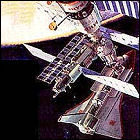 With work having started mere days earlier on Buran, a Soviet version of the American space shuttle design, the Soviet Union’s space agency is given new marching orders to create a new generation of space station hardware, based on the experience gained thus far with the four Salyut space stations and their associated Almaz military space hardware. A modular design is chosen, with multiple docking ports and multiple station components launched over a period of time, concepts which will be tested with yet-to-be-launched Salyut stations. Frequently fighting with the Buran shuttle development program for money and resources (despite the fact that the two spacecraft are expected to be compatible), this new station will not be launched until 1986, almost exactly ten years later, at which time it will be known as Mir.
With work having started mere days earlier on Buran, a Soviet version of the American space shuttle design, the Soviet Union’s space agency is given new marching orders to create a new generation of space station hardware, based on the experience gained thus far with the four Salyut space stations and their associated Almaz military space hardware. A modular design is chosen, with multiple docking ports and multiple station components launched over a period of time, concepts which will be tested with yet-to-be-launched Salyut stations. Frequently fighting with the Buran shuttle development program for money and resources (despite the fact that the two spacecraft are expected to be compatible), this new station will not be launched until 1986, almost exactly ten years later, at which time it will be known as Mir.
Soviet shuttle startup
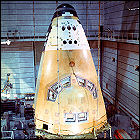 Fearing that the relatively sleek, aerodynamic design of the still-unflown American Space Shuttle is a hint that the vehicle could see use as an orbital bomber, the Kremlin orders the creation of the Soviet Space Shuttle program, though work on the vehicle, codenamed Buran (“Snowflake”), is primarily a crash program within the country’s defense department rather than the civilian branch of its space program. Within months, it is concluded that Buran will closely copy the American shuttle design due to the soundness of its aerodynamic design.
Fearing that the relatively sleek, aerodynamic design of the still-unflown American Space Shuttle is a hint that the vehicle could see use as an orbital bomber, the Kremlin orders the creation of the Soviet Space Shuttle program, though work on the vehicle, codenamed Buran (“Snowflake”), is primarily a crash program within the country’s defense department rather than the civilian branch of its space program. Within months, it is concluded that Buran will closely copy the American shuttle design due to the soundness of its aerodynamic design.
STA-099
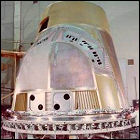 Construction begins on Space Shuttle Structural Test Article 099 (STA-099), a full-sized structural model of the shuttle built for stress and thermal testing. Four years later, NASA decides to abandon plans to refit the test shuttle Enterprise for space duty at great expense, instead opting to upgrade the STA-099 airframe into a spaceworthy vehicle, which will eventually be named Challenger. While the refit will still be expensive, it takes less time and money than a complete teardown and rebuild of Enterprise’s airframe, which was never intended for flight outside the atmosphere.
Construction begins on Space Shuttle Structural Test Article 099 (STA-099), a full-sized structural model of the shuttle built for stress and thermal testing. Four years later, NASA decides to abandon plans to refit the test shuttle Enterprise for space duty at great expense, instead opting to upgrade the STA-099 airframe into a spaceworthy vehicle, which will eventually be named Challenger. While the refit will still be expensive, it takes less time and money than a complete teardown and rebuild of Enterprise’s airframe, which was never intended for flight outside the atmosphere.
Apollo’s final descent danger
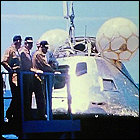 The “age of Apollo” comes to an unbreathable end in an incident during the return of the final Apollo spacecraft. Returning from their successful Apollo-Soyuz Test Project flight, astronauts Thomas Stafford, Deke Slayton and Vance Brand are exposed to fumes from their vehicle’s own reaction control thrusters, thanks to the thrusters firing after the capsule’s air vents open during descent toward the Pacific Ocean. Brand reportedly passes out momentarily due to the toxic fumes. All three astronauts are hospitalized for two weeks in Hawaii.
The “age of Apollo” comes to an unbreathable end in an incident during the return of the final Apollo spacecraft. Returning from their successful Apollo-Soyuz Test Project flight, astronauts Thomas Stafford, Deke Slayton and Vance Brand are exposed to fumes from their vehicle’s own reaction control thrusters, thanks to the thrusters firing after the capsule’s air vents open during descent toward the Pacific Ocean. Brand reportedly passes out momentarily due to the toxic fumes. All three astronauts are hospitalized for two weeks in Hawaii.
Apollo-Soyuz: thawing the Cold War in orbit
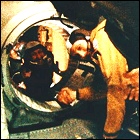 The last Apollo spacecraft to fly makes history by docking with a Soviet-launched Soyuz spacecraft in orbit, allowing the crews to visit each other and conduct joint scientific experiments. The first docking of the Apollo-Soyuz Test Project is hailed as a major development in international relations as well as spaceflight, though it will be 20 years before the feat is repeated. Plans for a second Apollo-Soyuz flight the following year are scuttled due to budget concerns, and the need to commence work on converting NASA’s launch facilities for future shuttle launches rather than further Apollo launches.
The last Apollo spacecraft to fly makes history by docking with a Soviet-launched Soyuz spacecraft in orbit, allowing the crews to visit each other and conduct joint scientific experiments. The first docking of the Apollo-Soyuz Test Project is hailed as a major development in international relations as well as spaceflight, though it will be 20 years before the feat is repeated. Plans for a second Apollo-Soyuz flight the following year are scuttled due to budget concerns, and the need to commence work on converting NASA’s launch facilities for future shuttle launches rather than further Apollo launches.
Apollo-Soyuz and Soyuz 19
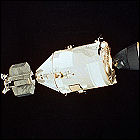 The final launch of an Apollo spacecraft takes place as the last Saturn rocket carries the American component of the Apollo-Soyuz Test Project into orbit. A cooperative international mission intended to see the Apollo capsule dock with a Soviet-launched Soyuz, the ASTP will be the last Apollo flight as the push toward the reusable Space Shuttle takes over NASA’s resources and planning. Aboard the Apollo command/service module are Commander Thomas Stafford, command module pilot Vance Brand, and docking module pilot Deke Slayton, the last of the seven original Mercury astronauts to reach space (heart conditions have prevented him from taking part in a mission until now). Soyuz 19, carrying cosmonauts Alexei Leonov and Valery Kubasov, lifts off a few hours earlier.
The final launch of an Apollo spacecraft takes place as the last Saturn rocket carries the American component of the Apollo-Soyuz Test Project into orbit. A cooperative international mission intended to see the Apollo capsule dock with a Soviet-launched Soyuz, the ASTP will be the last Apollo flight as the push toward the reusable Space Shuttle takes over NASA’s resources and planning. Aboard the Apollo command/service module are Commander Thomas Stafford, command module pilot Vance Brand, and docking module pilot Deke Slayton, the last of the seven original Mercury astronauts to reach space (heart conditions have prevented him from taking part in a mission until now). Soyuz 19, carrying cosmonauts Alexei Leonov and Valery Kubasov, lifts off a few hours earlier.
Soyuz 18
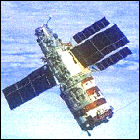 Soyuz 18 is launched toward space station Salyut 4 by the Soviet Union. Cosmonauts Pyotr Klimuk and Vitali Sevastyanov set a new Soviet record for long-duration stays in space, remaining about Salyut 4 for two months. They are also aboard Salyut 4 during the entirety of the Apollo-Soyuz Test Project, and are able to contact that international mission’s Soviet crew in another Soyuz vehicle. (Two mission control centers are used to prevent any confusion between the two Soyuz crews.) At the time the Soyuz 18 crew abandons Salyut 4 in July, the station’s environmental systems are failing, allowing the atmosphere inside the station to become humid enough for mold to begin growing on surfaces in the crew compartment; no further human crews will visit the station.
Soyuz 18 is launched toward space station Salyut 4 by the Soviet Union. Cosmonauts Pyotr Klimuk and Vitali Sevastyanov set a new Soviet record for long-duration stays in space, remaining about Salyut 4 for two months. They are also aboard Salyut 4 during the entirety of the Apollo-Soyuz Test Project, and are able to contact that international mission’s Soviet crew in another Soyuz vehicle. (Two mission control centers are used to prevent any confusion between the two Soyuz crews.) At the time the Soyuz 18 crew abandons Salyut 4 in July, the station’s environmental systems are failing, allowing the atmosphere inside the station to become humid enough for mold to begin growing on surfaces in the crew compartment; no further human crews will visit the station.
Soyuz 18a: “The April 5th Anomaly”
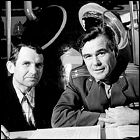 The two-man crew selected to become the second group of occupants for the Soviet Union’s Salyut 4 space station nearly rockets into disaster. Interstage connectors, intended to open simultaneously to allow the third stage of the booster to carry the Soyuz spacecraft into orbit, fail to open on cue, leaving the third stage dragging the dead weight of the spent second stage, changing the trajectory of the entire vehicle. The Soyuz capsule carrying cosmonauts Vasili Lazarev and Oleg Makarov is blasted free, and the two men experience acceleration of 23 Gs as the capsule roars toward a bruisingly rough emergency landing. As if that’s not bad enough, the Soyuz capsule lands perilously close to the USSR’s border with China, and rescue crews spend over 24 hours looking for the crew. The usually secretive Soviet space agency reluctantly reveals details of the mission to NASA, with whom they are collaborating ahead of the historic Apollo-Soyuz joint launch.
The two-man crew selected to become the second group of occupants for the Soviet Union’s Salyut 4 space station nearly rockets into disaster. Interstage connectors, intended to open simultaneously to allow the third stage of the booster to carry the Soyuz spacecraft into orbit, fail to open on cue, leaving the third stage dragging the dead weight of the spent second stage, changing the trajectory of the entire vehicle. The Soyuz capsule carrying cosmonauts Vasili Lazarev and Oleg Makarov is blasted free, and the two men experience acceleration of 23 Gs as the capsule roars toward a bruisingly rough emergency landing. As if that’s not bad enough, the Soyuz capsule lands perilously close to the USSR’s border with China, and rescue crews spend over 24 hours looking for the crew. The usually secretive Soviet space agency reluctantly reveals details of the mission to NASA, with whom they are collaborating ahead of the historic Apollo-Soyuz joint launch.
Columbia under construction
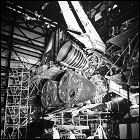 Construction begins on Space Shuttle Orbiter Vehicle 102 (OV-102 for short), the shuttle orbiter that NASA intends to launch as early as 1977. But OV-102 encounters the inherent pitfalls of being the first of its kind: years of delays are ahead, with many of the delays linked to the complicated system of protective thermal tiles designed to bear the brunt of the shuttle’s punishing re-entry through the atmosphere. (The test orbiter, later named Enterprise, is never intended for spaceflight, so it only has to conform to the shape and weight of a returning shuttle for landing tests, and therefore it doesn’t face the same hurdles.) OV-102’s first flight won’t take place until 1981, leaving a six-year gap between manned American spaceflights; during this period OV-102 will be named Columbia.
Construction begins on Space Shuttle Orbiter Vehicle 102 (OV-102 for short), the shuttle orbiter that NASA intends to launch as early as 1977. But OV-102 encounters the inherent pitfalls of being the first of its kind: years of delays are ahead, with many of the delays linked to the complicated system of protective thermal tiles designed to bear the brunt of the shuttle’s punishing re-entry through the atmosphere. (The test orbiter, later named Enterprise, is never intended for spaceflight, so it only has to conform to the shape and weight of a returning shuttle for landing tests, and therefore it doesn’t face the same hurdles.) OV-102’s first flight won’t take place until 1981, leaving a six-year gap between manned American spaceflights; during this period OV-102 will be named Columbia.
Shuttle schedule slippage
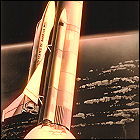 With the final Apollo spacecraft’s flight mere months away, an internal NASA document examining the progress of the Space Shuttle program, approved in 1972 by President Nixon, spells out what seems like a worst-case scenario: thanks to the difficulties of creating whole new orders of technology to create a reusable space vehicle (on a budget which each successive Congress keeps slashing), the shuttle won’t be lifting off until 1979 at the earliest, leaving a potential four-year gap in American crewed spaceflight when NASA was anticipating (and publicizing) a gap of no more than two years. (In actuality, the time between crewed American space missions will be even longer than that.)
With the final Apollo spacecraft’s flight mere months away, an internal NASA document examining the progress of the Space Shuttle program, approved in 1972 by President Nixon, spells out what seems like a worst-case scenario: thanks to the difficulties of creating whole new orders of technology to create a reusable space vehicle (on a budget which each successive Congress keeps slashing), the shuttle won’t be lifting off until 1979 at the earliest, leaving a potential four-year gap in American crewed spaceflight when NASA was anticipating (and publicizing) a gap of no more than two years. (In actuality, the time between crewed American space missions will be even longer than that.)
Salyut 3: first weapon fired in space
 One day before deorbiting the vacant space station for reentry into Earth’s atmosphere, Soviet military space officials fire the anti-aircraft cannon mounted on the exterior of space station Salyut 3 – the first test of spacecraft-to-spacecraft weapons in history (though there is no target on which to test the ammunition rounds). Without a steerable mount, in practice, the entire Salyut 3 station would need to have been pointed at the gun’s target. The station is destroyed by friction upon atmospheric reentry a day later.
One day before deorbiting the vacant space station for reentry into Earth’s atmosphere, Soviet military space officials fire the anti-aircraft cannon mounted on the exterior of space station Salyut 3 – the first test of spacecraft-to-spacecraft weapons in history (though there is no target on which to test the ammunition rounds). Without a steerable mount, in practice, the entire Salyut 3 station would need to have been pointed at the gun’s target. The station is destroyed by friction upon atmospheric reentry a day later.
Soyuz 17
 Soyuz 17 is launched by the Soviet Union, carring cosmonauts Alexei Gubarev and Georgi Grechko to the Salyut 4 space station. The two men move into the station for a month-long stay, breaking the previous Soviet space record, and proceed to conduct several science experiments. Discovering that the mirror of Salyut 4’s on-board telescope is warped, the crew resurfaces it in orbit and repairs the telescope. When Soyuz 17 returns to Earth, the crew is in for one of the bumpiest landings of the Soviet space program to date, landing in a blizzard with 45mph winds at ground level. Despite this, the vehicle lands safely and the crew is not injured.
Soyuz 17 is launched by the Soviet Union, carring cosmonauts Alexei Gubarev and Georgi Grechko to the Salyut 4 space station. The two men move into the station for a month-long stay, breaking the previous Soviet space record, and proceed to conduct several science experiments. Discovering that the mirror of Salyut 4’s on-board telescope is warped, the crew resurfaces it in orbit and repairs the telescope. When Soyuz 17 returns to Earth, the crew is in for one of the bumpiest landings of the Soviet space program to date, landing in a blizzard with 45mph winds at ground level. Despite this, the vehicle lands safely and the crew is not injured.
Salyut 4
 The Soviet Union launches its fourth orbital space station, Salyut 4. Much like Skylab, Salyut 4 is fitted with a solar telescope and X-ray astronomy equipment, which is trained on the X-ray source (and potential black hole) Cygnus X-1 during its flight. Three crews will go on to occupy Salyut 4 before it is deorbited in 1977; it is the first Soviet space station to successfully be occupied by multiple crews.
The Soviet Union launches its fourth orbital space station, Salyut 4. Much like Skylab, Salyut 4 is fitted with a solar telescope and X-ray astronomy equipment, which is trained on the X-ray source (and potential black hole) Cygnus X-1 during its flight. Three crews will go on to occupy Salyut 4 before it is deorbited in 1977; it is the first Soviet space station to successfully be occupied by multiple crews.
Soyuz 16
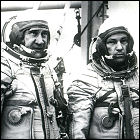 The Soviet Union launches Soyuz 16, a six-day manned space mission to test modifications to the Soyuz vehicle design ahead of 1975‘s Apollo-Soyuz Test Project international flight. Cosmonauts Anatoly Filipchenko and Nikolai Rukavishnikov test the new Soyuz docking mechanism and solar panels, and new rendezvous/docking equipment intended to assist with the Apollo-Soyuz flight as well as to prevent “wasted” missions such as Soyuz 15.
The Soviet Union launches Soyuz 16, a six-day manned space mission to test modifications to the Soyuz vehicle design ahead of 1975‘s Apollo-Soyuz Test Project international flight. Cosmonauts Anatoly Filipchenko and Nikolai Rukavishnikov test the new Soyuz docking mechanism and solar panels, and new rendezvous/docking equipment intended to assist with the Apollo-Soyuz flight as well as to prevent “wasted” missions such as Soyuz 15.
Soyuz 15
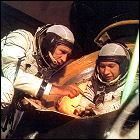 The Soviet space program continues with the launch of Soyuz 15, carrying cosmonauts Lev Dyomin and Gennadi Sarafanov. This is intended to be the second crew to occupy the Salyut 3 military space station, but spacecraft systems intended to automate the rendezvous and docking process fail. After manual dockings are attempted, the Soyuz vehicle is running low on fuel and the crew is recalled to Earth after only two days. (Trying to dodge questions about the nature of Salyut 3’s mission objectives, Soviet space authorities later claim that Soyuz 15 was never going to dock with the station.) No further crews are sent to board Salyut 3.
The Soviet space program continues with the launch of Soyuz 15, carrying cosmonauts Lev Dyomin and Gennadi Sarafanov. This is intended to be the second crew to occupy the Salyut 3 military space station, but spacecraft systems intended to automate the rendezvous and docking process fail. After manual dockings are attempted, the Soyuz vehicle is running low on fuel and the crew is recalled to Earth after only two days. (Trying to dodge questions about the nature of Salyut 3’s mission objectives, Soviet space authorities later claim that Soyuz 15 was never going to dock with the station.) No further crews are sent to board Salyut 3.
Soyuz 14
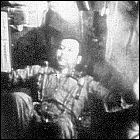 The Soviet Union launches the Soyuz 14 mission, sending cosmonauts Yuri Artyukhin and Pavel Popovich to embark on a two-week stay aboard the Salyut 3 military space station. Though some medical science experiments are performed at Salyut 3, the majority of the crew’s time is taken up with observations of the Earth’s surface, essentially making Salyut 3 the first manned military surveillance satellite. Before leaving, the crew of two offloads supplies so that the new Salyut 3 crew can stay for several months.
The Soviet Union launches the Soyuz 14 mission, sending cosmonauts Yuri Artyukhin and Pavel Popovich to embark on a two-week stay aboard the Salyut 3 military space station. Though some medical science experiments are performed at Salyut 3, the majority of the crew’s time is taken up with observations of the Earth’s surface, essentially making Salyut 3 the first manned military surveillance satellite. Before leaving, the crew of two offloads supplies so that the new Salyut 3 crew can stay for several months.
Salyut 3: packin’ heat in orbit
 The Soviet Union launches its third space station, again based on the Almaz military space station architecture. Salyut 3 remains in orbit for over half a year, and is eventually visited by the crews of Soyuz 14 and Soyuz 15, though the latter mission fails to dock. Despite international agreements already in place to prevent the militarization of space, Salyut 3 is the first armed space station, packing a non-steerable anti-aircraft gun (for defending the station, though from what is never made clear). Fortunately, the space war never happens and Salyut 3 is never forced to defend itself.
The Soviet Union launches its third space station, again based on the Almaz military space station architecture. Salyut 3 remains in orbit for over half a year, and is eventually visited by the crews of Soyuz 14 and Soyuz 15, though the latter mission fails to dock. Despite international agreements already in place to prevent the militarization of space, Salyut 3 is the first armed space station, packing a non-steerable anti-aircraft gun (for defending the station, though from what is never made clear). Fortunately, the space war never happens and Salyut 3 is never forced to defend itself.
Enterprise in drydock
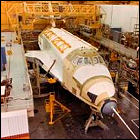 Construction begins on OV-101, a Space Shuttle intended for extensive atmospheric test flight and landings without ever going into space. Originally intended to bear the name Constitution, a letter-writing campaign by Star Trek fans convinces President Gerald Ford to request that NASA rename the first shuttle Enterprise. Much of the first shuttle’s structural details are simply dummy models of the correct shape and weight; her engines are never intended to fire. Though plans are drawn up to convert Enterprise into a space-worthy vehicle, they are never carried out: it’s deemed cheaper and faster to upgrade a structural test model of the shuttle instead.
Construction begins on OV-101, a Space Shuttle intended for extensive atmospheric test flight and landings without ever going into space. Originally intended to bear the name Constitution, a letter-writing campaign by Star Trek fans convinces President Gerald Ford to request that NASA rename the first shuttle Enterprise. Much of the first shuttle’s structural details are simply dummy models of the correct shape and weight; her engines are never intended to fire. Though plans are drawn up to convert Enterprise into a space-worthy vehicle, they are never carried out: it’s deemed cheaper and faster to upgrade a structural test model of the shuttle instead.
Soyuz 13
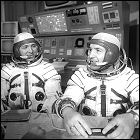 Cosmonauts Pyotr Klimuk and Valentin Lebedev lift off aboard Soyuz 13, the second proving flight of the redesigned Soyuz spacecraft. Their eight-day-long stay in Earth orbit is a Soviet space program rarity: a flight devoted solely to scientific observations with no military objectives. Many of the science experiments were originally intended to be conducted on board the Salyut 1 space station. Much like the Skylab 4 crew, which is in orbit at the same time, the Soyuz 13 crew is able to observe Comet Kohoutek.
Cosmonauts Pyotr Klimuk and Valentin Lebedev lift off aboard Soyuz 13, the second proving flight of the redesigned Soyuz spacecraft. Their eight-day-long stay in Earth orbit is a Soviet space program rarity: a flight devoted solely to scientific observations with no military objectives. Many of the science experiments were originally intended to be conducted on board the Salyut 1 space station. Much like the Skylab 4 crew, which is in orbit at the same time, the Soyuz 13 crew is able to observe Comet Kohoutek.
Skylab 4
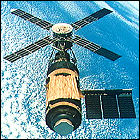 The third and final crew of the first American space station, Skylab 4, lifts off for an 84-day stay. The crew’s tasks include medical and biological experiments, solar observations (including the first space-based recording of solar flare origination), and observations of Comet Kohoutek. Crewmembers Gerald Carr, William Pogue and Edward Gibson have a frank discussion with ground controllers about their extremely busy work schedule (similar to heated discussions between Apollo 7’s crew and Houston) halfway through the nearly-three-month mission. Skylab is left powered down, but still habitable, at the end of the crew’s stay, in anticipation that future Space Shuttle crews will someday occupy Skylab.
The third and final crew of the first American space station, Skylab 4, lifts off for an 84-day stay. The crew’s tasks include medical and biological experiments, solar observations (including the first space-based recording of solar flare origination), and observations of Comet Kohoutek. Crewmembers Gerald Carr, William Pogue and Edward Gibson have a frank discussion with ground controllers about their extremely busy work schedule (similar to heated discussions between Apollo 7’s crew and Houston) halfway through the nearly-three-month mission. Skylab is left powered down, but still habitable, at the end of the crew’s stay, in anticipation that future Space Shuttle crews will someday occupy Skylab.
Soyuz 12: the USSR returns to space
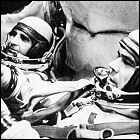 After two years of reorganization and rethinking, the Soviet manned space program resumes with the launch of Soyuz 12, carrying cosmonauts Vasili Lazarev and Oleg Makarov. Previously a three-seater, Soyuz has been redesigned following the Soyuz 11 tragedy: the vehicle now seats a crew of two, both wearing fully pressurized spacesuits. Originally intended to visit the Salyut 2 station, Soyuz 12 is only a two-day shakedown flight for the redesigned spacecraft (Salyut 2’s own technical problems have rendered it uninhabitable by a human crew).
After two years of reorganization and rethinking, the Soviet manned space program resumes with the launch of Soyuz 12, carrying cosmonauts Vasili Lazarev and Oleg Makarov. Previously a three-seater, Soyuz has been redesigned following the Soyuz 11 tragedy: the vehicle now seats a crew of two, both wearing fully pressurized spacesuits. Originally intended to visit the Salyut 2 station, Soyuz 12 is only a two-day shakedown flight for the redesigned spacecraft (Salyut 2’s own technical problems have rendered it uninhabitable by a human crew).
Skylab rescue mission prepared
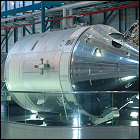 A thruster leak in the Skylab 3 crew’s Apollo command/service module forces NASA to consider a Skylab Rescue mission using a modified five-seater Apollo vehicle, mounted atop a Saturn IB and rolled out to the pad in readiness for the emergency flight. NASA brings in enough engineers and employees to have shifts working around the clock, seven days a week, to get the emergency mission ready for launch on September 9th. The thruster issue is later resolved, and the first-ever planned space rescue mission stands down. Astronauts Vance Brand and Don Lind are assigned to the rescue mission; both men later flew the Space Shuttle, though Brand will also fly in the Apollo-Soyuz Test Project. The modified command/service module and Saturn rocket are retained in case a rescue is needed for the final Skylab flight, and then as an Apollo-Soyuz backup vehicle, before being retired and displayed at the Smithsonian and Kennedy Space Center.
A thruster leak in the Skylab 3 crew’s Apollo command/service module forces NASA to consider a Skylab Rescue mission using a modified five-seater Apollo vehicle, mounted atop a Saturn IB and rolled out to the pad in readiness for the emergency flight. NASA brings in enough engineers and employees to have shifts working around the clock, seven days a week, to get the emergency mission ready for launch on September 9th. The thruster issue is later resolved, and the first-ever planned space rescue mission stands down. Astronauts Vance Brand and Don Lind are assigned to the rescue mission; both men later flew the Space Shuttle, though Brand will also fly in the Apollo-Soyuz Test Project. The modified command/service module and Saturn rocket are retained in case a rescue is needed for the final Skylab flight, and then as an Apollo-Soyuz backup vehicle, before being retired and displayed at the Smithsonian and Kennedy Space Center.
Skylab 3
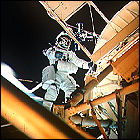 With the first Skylab crew having salvaged the first American space station, the second crew – designated Skylab 3 – lifts off for another long-term stay in space. Alan Bean, Jack Lousma and Owen Garriott spend 59 days aboard Skylab, performing a spacewalk to conduct further repairs to their damaged space station, investigating the effects of long-duration weightlessness and space travel on the human body, and observing the sun through Skylab’s solar telescope system. A thruster leak in the Apollo command/service module forces NASA to consider a rescue mission.
With the first Skylab crew having salvaged the first American space station, the second crew – designated Skylab 3 – lifts off for another long-term stay in space. Alan Bean, Jack Lousma and Owen Garriott spend 59 days aboard Skylab, performing a spacewalk to conduct further repairs to their damaged space station, investigating the effects of long-duration weightlessness and space travel on the human body, and observing the sun through Skylab’s solar telescope system. A thruster leak in the Apollo command/service module forces NASA to consider a rescue mission.
Skylab 2: mission accomplished
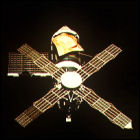 Having repaired and secured the damaged Skylab over the course of three spacewalks, the space station’s first three-man crew leaves the station and returns to Earth after 28 days in space, experiencing gravity after nearly a month of zero-G.
Having repaired and secured the damaged Skylab over the course of three spacewalks, the space station’s first three-man crew leaves the station and returns to Earth after 28 days in space, experiencing gravity after nearly a month of zero-G.
The first Skylab crew’s stay in space sets a new record, twice as long as the previous longest American manned spaceflight, Gemini 7 in 1965.
Skylab 2: risky repair job
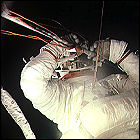 Two members of Skylab‘s first three-man crew undertake a three-and-a-half-hour spacewalk to take on the most difficult and dangerous part of the repairs to the space station: freeing a jammed solar “wing” required to provide almost half of the station’s electrical power. With no handholds and only tethers keeping them anchored to the station, astronauts Pete Conrad and Joseph Kerwin have a hard time even reaching the solar panel, and are knocked loose when, after overexerting themselves trying to manually pull the panel free, it jerks open; with only their tethers keeping them attached to Skylab, it’s a potentially life-threatening situation for both. Conrad, the third man to walk on the moon, later admits that the Skylab repair spacewalk gave him much greater concern for his own survival.
Two members of Skylab‘s first three-man crew undertake a three-and-a-half-hour spacewalk to take on the most difficult and dangerous part of the repairs to the space station: freeing a jammed solar “wing” required to provide almost half of the station’s electrical power. With no handholds and only tethers keeping them anchored to the station, astronauts Pete Conrad and Joseph Kerwin have a hard time even reaching the solar panel, and are knocked loose when, after overexerting themselves trying to manually pull the panel free, it jerks open; with only their tethers keeping them attached to Skylab, it’s a potentially life-threatening situation for both. Conrad, the third man to walk on the moon, later admits that the Skylab repair spacewalk gave him much greater concern for his own survival.
Skylab 2: save the station!
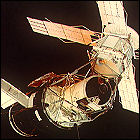 The first three-man Skylab crew lifts off to undertake a mission far different from the one for which they had trained. Their primary objective is now to save the crippled station from the damage it suffered during launch; as it is, Skylab is uninhabitable, with temperatures in its workshop and crew quarters soaring above 100 degrees, threatening to heat up items inside enough to fill the space with toxic gases. The first repair spacewalk takes place less than 24 hours after the crew arrives in an Apollo capsule, and succeeds in starting to drop the temperature inside.
The first three-man Skylab crew lifts off to undertake a mission far different from the one for which they had trained. Their primary objective is now to save the crippled station from the damage it suffered during launch; as it is, Skylab is uninhabitable, with temperatures in its workshop and crew quarters soaring above 100 degrees, threatening to heat up items inside enough to fill the space with toxic gases. The first repair spacewalk takes place less than 24 hours after the crew arrives in an Apollo capsule, and succeeds in starting to drop the temperature inside.
Skylab launched
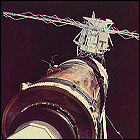 The first American space station, Skylab, is launched unmanned atop the last Saturn V rocket ever to be flown. Within minutes, however, it’s obvious that the space station – whose habitable space is actually the heavily modified third stage of the Saturn V – is already in serious trouble. Launch vibrations rip off one of the solar panels, and the other panel fails to automatically open. With less than two weeks before the first Skylab crew is due to lift off, the clock is ticking for mission planners to devise contingency and repair procedures.
The first American space station, Skylab, is launched unmanned atop the last Saturn V rocket ever to be flown. Within minutes, however, it’s obvious that the space station – whose habitable space is actually the heavily modified third stage of the Saturn V – is already in serious trouble. Launch vibrations rip off one of the solar panels, and the other panel fails to automatically open. With less than two weeks before the first Skylab crew is due to lift off, the clock is ticking for mission planners to devise contingency and repair procedures.
Salyut 2: first military space station
 The Soviet Union launches a second space station, and the first station designed exclusively for military tasks in orbit. Salyut 2 is the first station to use the Almaz military space station design devised in the 1960s as a response to the US Air Force’s never-flown Manned Orbiting Laboratory. Within two weeks, however, technical difficulties take their toll: Salyut 2 begins to tumble out of control, and its crew compartment depressurizes. (The redesigned Soyuz vehicle is not ready to fly yet, so no crew ever visits Salyut 2.) The second Soviet space station burns up in the atmosphere less than two months after launch.
The Soviet Union launches a second space station, and the first station designed exclusively for military tasks in orbit. Salyut 2 is the first station to use the Almaz military space station design devised in the 1960s as a response to the US Air Force’s never-flown Manned Orbiting Laboratory. Within two weeks, however, technical difficulties take their toll: Salyut 2 begins to tumble out of control, and its crew compartment depressurizes. (The redesigned Soyuz vehicle is not ready to fly yet, so no crew ever visits Salyut 2.) The second Soviet space station burns up in the atmosphere less than two months after launch.
Apollo 17: the last man on the moon
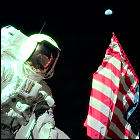 The final manned lunar landing mission lifts off atop a Saturn V rocket. Apollo 17 is the first mission to include a qualified geologist, Harrison Schmitt, in its crew; Gene Cernan and Schmitt descend to the surface aboard the lunar lander Challenger, where the last two men to walk on the moon spend a total of 22 hours exploring the Taurus-Littrow valley. For the third mission in a row, a lunar rover is stowed into one side of the lander. Astronaut Ron Evans orbits overhead in the command/service module America. The astronauts return on December 19th, bringing home nearly 250 pounds of lunar soil and rock samples.
The final manned lunar landing mission lifts off atop a Saturn V rocket. Apollo 17 is the first mission to include a qualified geologist, Harrison Schmitt, in its crew; Gene Cernan and Schmitt descend to the surface aboard the lunar lander Challenger, where the last two men to walk on the moon spend a total of 22 hours exploring the Taurus-Littrow valley. For the third mission in a row, a lunar rover is stowed into one side of the lander. Astronaut Ron Evans orbits overhead in the command/service module America. The astronauts return on December 19th, bringing home nearly 250 pounds of lunar soil and rock samples.